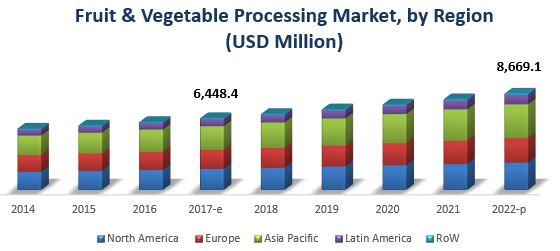The global fruit & vegetable processing enzymes market has grown steadily in the last few years. The market size is projected to reach USD 41.39 Billion by 2022, at a CAGR of around 6.7% from 2016 to 2022. The market is driven by factors such as improved quality and yield for fruit & vegetable juices and beverages, high demand for convenience foods, increasing awareness for healthy foods, and high specificity of enzymes in biochemical reactions. The high growth potential in the emerging markets and untapped regions provides new growth opportunities for market players.

The objectives of the study includes:
- To define, segment, and project the global market for fruit & vegetable processing enzymes
- To understand the structure of the fruit & vegetable processing enzymes market by identifying its various subsegments
- To provide detailed information about the key factors influencing the growth of the market (drivers, restraints, opportunities, industry-specific challenges, and burning issues)
- To strategically analyze micromarkets1 with respect to individual growth trends, future prospects, and their contribution to the total market
Download PDF Brochure:
https://www.marketsandmarkets.com/pdfdownloadNew.asp?id=253649892
Fruits are the fastest-growing segment in the fruit & vegetable processing enzymes market by application during the forecast period 2016–2022
Fruits contain different types of enzymes such as amylase, amyloglucosidase, and glutamic acid decarboxylase for each type, which help to improve their shelf life. These enzymes also provide health benefits in the form of vitamins and minerals, which reduces the risk of many diseases. Significant fruits, such as apple, oranges, and grapes contain natural enzymes that determine their quality. For instance, Apples naturally contain liquid acid amylase and amyloglucosidase as an enzyme, which converts starch to sugar maltose whereas proteases convert proteins into amino acids. Orange contains vitamin C and dietary fiber. It contains glutamic acid decarboxylase as an enzyme, which determine the quality of the fruit. It also contains pyridoxal phosphate, which prevents loss of nutritional properties from high temperature. Brazil is the leading producer of oranges, followed by the U.S. Grapes are commonly used for the production of wine and contains pectin enzymes, which are used to ferment and produce wine over a period of time.
Speak to Analyst:
https://www.marketsandmarkets.com/speaktoanalystNew.asp?id=253649892
Significant growth for fruit & vegetable processing enzymes is observed in the Asia-Pacific region
The Asia-Pacific region is expected to surpass Europe as the second-largest consumer of fruit & vegetable processing enzymes. This is due to the rising demand from India and China, which has contributed to the industrial growth for food & beverages. More than two-thirds of the fruit & vegetable processing enzymes market in the Asia-Pacific region is import-dominated. Therefore, enzyme manufacturers have investment opportunities in new product developments across the Asia-Pacific region.
This report includes a study of marketing and development strategies, along with the product portfolio of leading companies. It includes the profiles of leading companies such as E. I. du Pont de Nemours and Company (U.S.), Associated British Foods Plc (U.K.), Koninklijke DSM N.V. (The Netherlands), Novozymes A/S (Denmark), and Group Soufflet (France).
